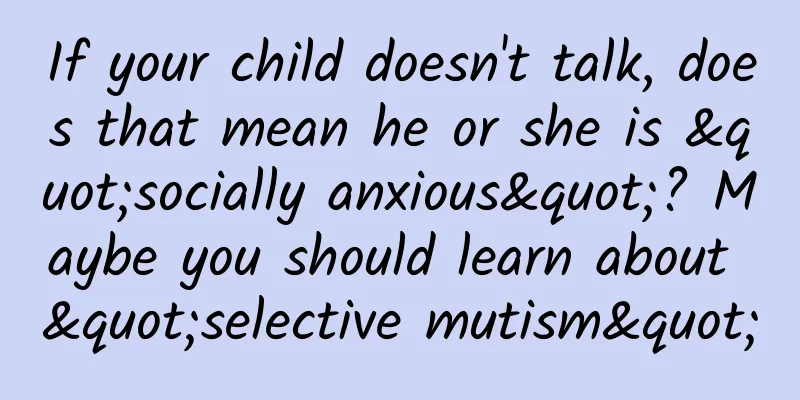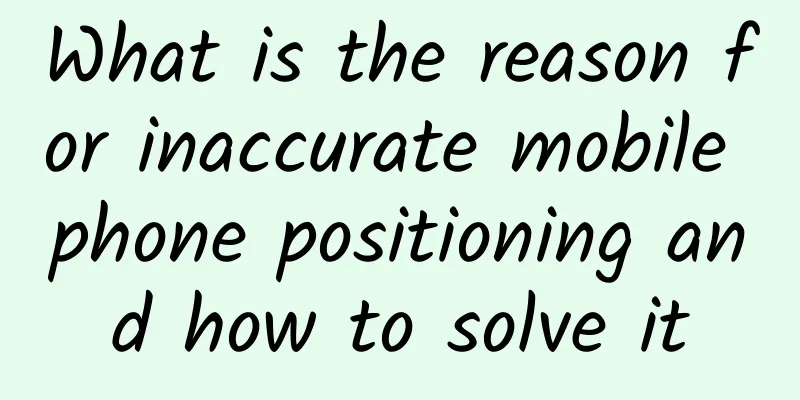If your child doesn't talk, does that mean he or she is "socially anxious"? Maybe you should learn about "selective mutism"

|
gossip Children who can talk happily and communicate freely at home may become silent and avoid communication at school or other specific occasions. Parents and teachers tend to attribute this to "shy, timid, and introverted" and sometimes even half-jokingly say, "How can such a young child still be socially anxious?" Is it just personality that makes children avoid communication? Is it true that children who don’t talk are “introverted” or “socially anxious”? analyze There may be many reasons why children refuse to speak or communicate in certain situations. We need to consider biological, psychological, family and social factors comprehensively, and cannot simply say "introverted". What parents and teachers need to pay special attention to and identify is the "silence" caused by children's anxiety disorders , such as children's selective mutism, children's separation anxiety disorder, social phobia, etc. Copyrighted stock images, no reproduction is authorized We also need to pay attention to another angle: On the Internet, an introvert is often described as "socially phobic", while real social phobia is also called social anxiety disorder, which has stricter diagnostic criteria in the field of psychiatry. If we go back to the scenario described above, it is also inappropriate to directly label an introverted child as "socially phobic". Children who choose not to speak: Rare "Selective mutism" For 4 and a half-year-old Qiqi, the kindergarten gate is like a "switch"; as soon as she steps into the kindergarten, her language function is turned off and she doesn't say a word. It has been almost a year since she entered the kindergarten, and Qiqi has hardly spoken to anyone; because it is difficult for her to communicate, the teacher often ignores Qiqi, and other children are unwilling to play with her. The paradox is that Qiqi is an active child at home, she talks a lot, loves to express herself, and interacts normally with her family. But she behaves like a completely different person outside: even when accompanied by her parents, Qiqi rarely speaks outside the home, refuses to greet others, and is nervous and reserved most of the time. Qiqi's parents didn't care about this at first. They thought that the child was just introverted and easily "shy of strangers", and that she would be fine after going to kindergarten. But after so long in kindergarten, Qiqi still doesn't speak, so it can't be explained by "introversion" or "shy of strangers". After a professional psychiatric examination, the psychiatrist told Kiki's mother that Kiki suffered from childhood selective mutism. Copyrighted stock images, no reproduction is authorized Selective mutism is an anxiety disorder (Selective Mutism, SM). Children with this disorder have normal language comprehension and expression abilities, but they selectively remain silent in certain specific situations that require language communication. In 2013, the newly published American Diagnostic and Statistical Manual of Mental Disorders (DSM-5) classified it as a childhood anxiety disorder. It is a rare disease with a prevalence of 0.2% to 2% among primary school students worldwide, more girls than boys, and an average age of onset of 2.7 to 4.1 years old. According to the Diagnostic and Statistical Manual of Mental Disorders, Fifth Edition (DSM-5), the diagnostic criteria for selective mutism are as follows: 1. A persistent inability to speak in specific social situations (e.g., at school) where speaking is expected, despite being able to speak in other situations. 2. The disorder interferes with educational or occupational achievement or social communication. 3. The duration of such impairment is at least 1 month (not limited to the first month of schooling). 4. The inability to speak is not attributable to lack of knowledge of, or discomfort with, the spoken language required for use in social situations. 5. The impairment is not better explained by a communication disorder (e.g., a fluency disorder that develops in childhood) and does not occur exclusively in the course of an autism spectrum disorder, schizophrenia, or another psychotic disorder. Copyrighted stock images, no reproduction is authorized The current mainstream view is that the cause of selective mutism is the result of the interaction of multiple factors. In studies that emphasize environmental factors, we can see cases like this: the father of the child is too strict and the mother is too protective; or the child has experienced the trauma of the sudden departure of an important caregiver, and then the mutism symptoms appear and gradually worsen. For some children with early onset, parents and teachers are accustomed to excessively expressing themselves verbally on their behalf, which also becomes one of the factors that maintain the symptoms. A study by Muris and Hendriks (2016) on children aged 3-6 found that behaviors with inhibitory nature, such as shyness, poor social skills, withdrawal and low adaptability, as well as social anxiety symptoms, have a high positive correlation with selective mutism (SM), indicating that people with anxious traits are more likely to suffer from this disease . Like other mental illnesses, SM has neurobiological causes. Currently, there are not many studies on this aspect. Some researchers believe that it may be related to abnormal auditory processing function. Compared with Westerners, Chinese people are generally more introverted. Children who do not speak when they start kindergarten or elementary school will be considered introverted or shy, and will be ignored by their parents or teachers, resulting in the children not being discovered and treated in time. Little patients like Qiqi have no problem talking to their parents at home; it is often not until they cannot talk normally with their teachers and classmates for a long time after going to school that they will attract the attention of their parents and schools. There are also children who show the opposite behavior: they do not say a word when they return home, but speak normally in other places. At present, with the rapid development of modern society, the number of children suffering from selective mutism is increasing. There are strict diagnostic criteria for "social phobia". It is also a type of anxiety disorder When "social phobia" became a buzzword on the Internet, many people would generalize it. If a child does not speak in certain situations and avoids socializing, people would often comment: "How can such a young child be socially phobic?" In fact, clinically defined "social phobia" is also known as social anxiety disorder, which has strict diagnostic criteria . Children with social anxiety disorder will show persistent fear of one or more social situations, and will try their best to avoid the social situations they fear. When they cannot avoid them, they will experience strong anxiety and depression, and the physical anxiety reaction has ruled out the corresponding organic disease. Copyrighted stock images, no reproduction is authorized Typical symptoms of social anxiety disorder also include verbal rejection or avoidance; children may not dare to face strangers, let alone talk to others, and may even feel nervous when seeing strangers. In addition, they may experience excessive panic and tension in public places such as kindergartens, playgrounds, and parks; and be afraid to communicate face-to-face with peers and adults in crowded places, and even if they do communicate, they will be in extreme fear. Moreover, social anxiety disorder has a high comorbidity rate with other anxiety disorders, and separation anxiety disorder and selective mutism are common in young children. In life, even if most children are shy and introverted, they can establish communication connections with others relatively smoothly after spending some time together and interacting with others and relaxing. In this case, the definition of "social phobia" is biased. If you observe that your child's nervousness and fear in social situations far exceeds the normal level, and it is difficult to adjust and relieve it continuously, parents should pay attention to it. Worried Child: The incidence of anxiety disorders in children is increasing year by year Anxiety is an emotion, and moderate anxiety can make people's behavior and thinking more agile, help improve efficiency and stay away from danger. But if you are still very nervous when you are not in a real crisis, or if you overreact to stressful events, it will become a problem; in serious cases, you will suffer from anxiety disorder. know Childhood anxiety disorders are common mental disorders among children and adolescents. In addition to the selective mutism and social anxiety disorder mentioned above, childhood anxiety disorders also include generalized anxiety disorder, panic disorder, childhood separation anxiety disorder, childhood phobia anxiety disorder, etc. Surveys show that 5%-20% of children worldwide have anxiety disorders, and an even greater proportion of children show anxiety symptoms without meeting diagnostic criteria . Data from a 2020 study showed that the prevalence among children was 13.2% for males and 15.1% for females; data from The Lancet in 2018 showed that the median age group for the onset of anxiety and impulse control disorders was 11-15 years old. Some types of anxiety disorders may improve after adolescence, but may persist into early adulthood or even longer, hindering the child's long-term psychological development, academic development, and interpersonal relationships. Causes Why do healthy children suffer from childhood anxiety disorders? Childhood anxiety disorders are affected by multiple factors, including biological, psychological, family, and social factors. First, studies have found that a considerable proportion of children with anxiety disorders are affected by family genetic factors. Molecular genetic studies in recent years have also proven that some genes are closely related to childhood anxiety; there are also corresponding positive correlation factors in neurobiology. From a psychological perspective, children with anxiety disorders often have irrational thoughts, feelings, and behaviors, overestimate dangers, and adopt negative coping strategies. As a result, they are unable to learn how to cope with difficulties, which aggravates the maintenance of anxiety. In the family, parents' overly controlling or emotionally neglectful parenting style, parent-child conflicts, family changes, etc. can all cause children to experience long-term tension and fear. Copyrighted stock images, no reproduction is authorized In addition, factors such as interpersonal conflicts in the school environment , school bullying, and involution promoted by social and cultural media can also aggravate children's anxiety symptoms. In recent years, my country has conducted surveys on children's behavioral and emotional disorders and found that the incidence of anxiety disorders among children and adolescents has increased year by year. Especially after the outbreak of the COVID-19 pandemic, the anxiety and panic caused by the sudden outbreak, the disruption of structured school life, and long-term online learning at home have all had an unprecedented impact on children's psychology. symptom If childhood anxiety symptoms can be identified early and intervened in time, it will be helpful to relieve the symptoms. The symptoms mainly include the following four aspects: Physical symptoms: headache, muscle tension, sweating, flushing, nausea, etc. Negative emotions: nervousness, excessive worry, sensitivity to unfamiliar environments, or irritability; Abnormal behavior: irritability, difficulty being comforted, restlessness, bad temper, decreased learning efficiency, lack of concentration, etc.; Negative cognition: excessive pursuit of perfection in doing things, excessive self-blame and pain when failing, etc. treat The overall treatment principle for childhood anxiety disorders is based on psychological and behavioral therapy . Behavioral therapy and cognitive behavioral therapy are commonly used and effective methods for treating anxiety disorders. Since children's anxiety often occurs when there are conflicts in family relationships and poor parenting styles, if the atmosphere between family members can be improved, children's anxiety can sometimes be relieved on its own. Therefore, family therapy is also an important way to intervene in children's anxiety. In addition, since children's language differentiation ability is not yet perfect and their non-verbal expression ability is stronger, sand tray and play therapy are also very suitable for children. We need to remind everyone that when anxiety is severe, parents should take their children to the hospital's psychiatric department for prompt diagnosis and, if necessary, medication. Copyrighted stock images, no reproduction is authorized in conclusion At present, the incidence of anxiety disorders in children is increasing year by year, and its symptoms may also include verbal rejection or avoidance. Parents should observe their children's various functions, such as speech and social performance, in different environments and scenarios. If there are relatively large differences, they need to pay attention and seek medical treatment in time. Simply defining a child who refuses to speak as "introverted" or "shy" may delay the opportunity for professional treatment. References: 1Guo Aige. Types of abnormal psychology of primary school students and their identification and intervention[J]. Educational Exploration, 2010(06):127-133. 2 Zhang Lili, Wang Lin. Understanding, prevention and coping strategies of children's anxiety[J]. Chinese Journal of Practical Pediatrics, 2022, 37(11): 808-812. DOI: 10.19538/j.ek2022110603. 3Xu Jie, Zhang Risheng. A case study of sandplay therapy for an 11-year-old girl with selective mutism[J]. Psychological Science, 2008(01):126-132.DOI:10.16719/j.cnki.1671-6981.2008.01.004. 4 Huang Hong. Children's emotional disorders and other common psychological and behavioral disorders[J]. Journal of Practical Pediatrics, 2006(23):1678-1680. 5 Zhou Yuxi, Li Yun, Song Xuming, et al. Research progress on selective mutism in children[J]. International Journal of Psychiatry, 2018, 45(06): 977-979+993. DOI: 10.13479/j.cnki.jip.2018.06.006. 6 Liu Zixuan, Li Yi. Overview of Selective Mutism Research [C]//Chinese Psychological Society. Abstracts of the 24th National Psychology Academic Conference. [Publisher unknown], 2022: 3. DOI: 10.26914/c.cnkihy.2022.071725. 7 Tang Ruiqiang. The past and present of selective mutism[J]. International Journal of Psychiatry, 2020, 47(05): 897-899. DOI: 10.13479/j.cnki.jip.2020.05.013. 8 Deng Anning. A case report of selective mutism in children[J]. Journal of Chongqing Medical University, 1996(01):78-79. Author: Dou Yuanyuan, psychological counselor, medical/psychology popular science author Reviewer: Ren Feng, MD, PhD Director of the Department of Psychiatry, Shougang Hospital, Peking University, Standing Committee Member of the Psychiatry Branch of the Beijing Medical Association Planning丨Zhong Yanping Editor|Li Mengxin The article is produced by "Science Refutes Facts" (ID: Science_Facts). Please indicate the source when reprinting. The cover image and images within this article are from the copyright gallery. Reprinting and quoting them may lead to copyright disputes. |
<<: Not only from north to south, but also from east to west, in a circle... "Where do birds go?"
Recommend
Microsoft will stop unlocking WP7.x devices after December 31
According to foreign media reports, Microsoft rece...
Typhoon Dusurui brought all kinds of oysters to the ground. Where did they come from? Can we eat them?
On July 28, Typhoon Dusurui made landfall on the ...
Duang! A complete collection of self-study Android materials
[[128183]] Text/Tikitoo I have learned Android fo...
Interpreting ASP.NET 5 & MVC6 Series (4): Core Technology and Environment Configuration
asp.net 5 is the next generation of asp.net. This...
Operational promotion: How to break the dilemma of weak traffic growth?
As competition in bidding advertising becomes inc...
NIO released its 2019 Q2 financial report, with losses expanding to 3.285 billion, and a cumulative loss of 40 billion in 4 years
Recently, NIO released its unaudited second quart...
7 Micro-Interactions to Improve User Experience
As we all know, we always judge a book by its cov...
"How did a deer from across the ocean end up on our national emblem?"
This is the national emblem of Antigua and Barbud...
Douyin brand went from a rookie to a super Douyin anchor in 3 days, a plan to cultivate tens of millions of Douyin anchors
Douyin Brands: From a rookie to a super Douyin an...
Why did the great "BT download" technology fail?
Last April, Bob Delamar and Jeremy Johnson became ...
Top 10 Arduino Embedded Development IDEs, Must-Haves for Hardware Engineers!
As we all know, Arduino is the most popular open ...
China Electronics Technology Standardization Institute: White Paper on Enterprise Digital Transformation (2021 Edition)
The digital economy is the future development dir...
Xiaomi App Store CPD Price and Resources Introduction
1. Service Introduction Xiaomi App Store is the f...
AR glasses want to completely break up with iPhone! Apple: I can't do that
While it’s easy to overstate the state of AR as a...
5 minutes to quickly build an iOS App
[[404179]] This article is reprinted from the WeC...









